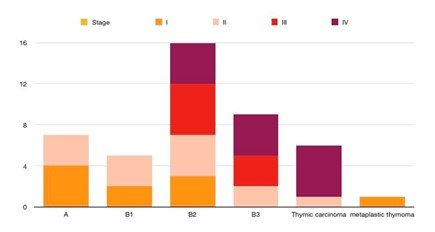Clinical characteristics, management, and outcomes of thymic malignancies: a tertiary centre experience in India
Keywords:
Thymoma, Masoka staging, ADOC, CAPAbstract
Introduction: Thymic malignancies are uncommon and very few studies are available, especially related to systemic combination therapy. Thus, the unmet needs in the standardisation of treatment approaches.
Materials and methods: This descriptive study retrospectively examined patients with thymic malignancies presented between January 2022 and May 2025. All patient, irrespective of stage or histotypes, were included in the study. Among 52 patients, data for analysis were available for 42 patients.
Results: Most patients had thymoma with B2 and B3 histology. 1/3rd of patients presented with Masoka stage IV. Stages III, II, and I were 23.8%, 21.4% and 23.8%. Patients with upfront resectable disease underwent surgery followed by adjuvant radiation therapy if high risk features were present. The commonly used regimens in potentially operable and inoperable tumours were combination adriamycin, cisplatin, vincristine, and cyclophosphamide (ADOC) and combination Cyclophosphamide, adriamycin and cisplatin (CAP) and paclitaxel-carboplatin. Disease control rate was 68.4 % with an overall response rate (ORR) of 52.6%. ORR were 55.5%, 50% and 40% with ADOC, CAP and paclitaxel-carboplatin, respectively. Neutropenia was seen in 42% the patients with grade ¾ in 15.7% of the patients. Two-year survival rates were 84%. Survival was shorter in patients with advanced disease thymic carcinoma. Stage-wise Survival rates for stage I, II, III, and IV were 100%, 89%, 79% and 71% (p value-0.04), respectively.
Conclusion: Modified Masoka staging is an important prognostic marker in Thymoma. Three or four drugs combination chemotherapy can be considered in potentially operable or inoperable tumours with good response rates and manageable toxicity profile.

Additional Files
Published
How to Cite
License
Copyright (c) 2025 Yaman Patidar, Lokesh KN, Guruprasad Shenoy , Darshan RS, Vivek B Maleyur, Kartik G Asutkar , Rudresh AH, Rajeev LK, Smitha C Saldanha , Suresh babu M C, Giri G V

This work is licensed under a Creative Commons Attribution-NonCommercial 4.0 International License.
